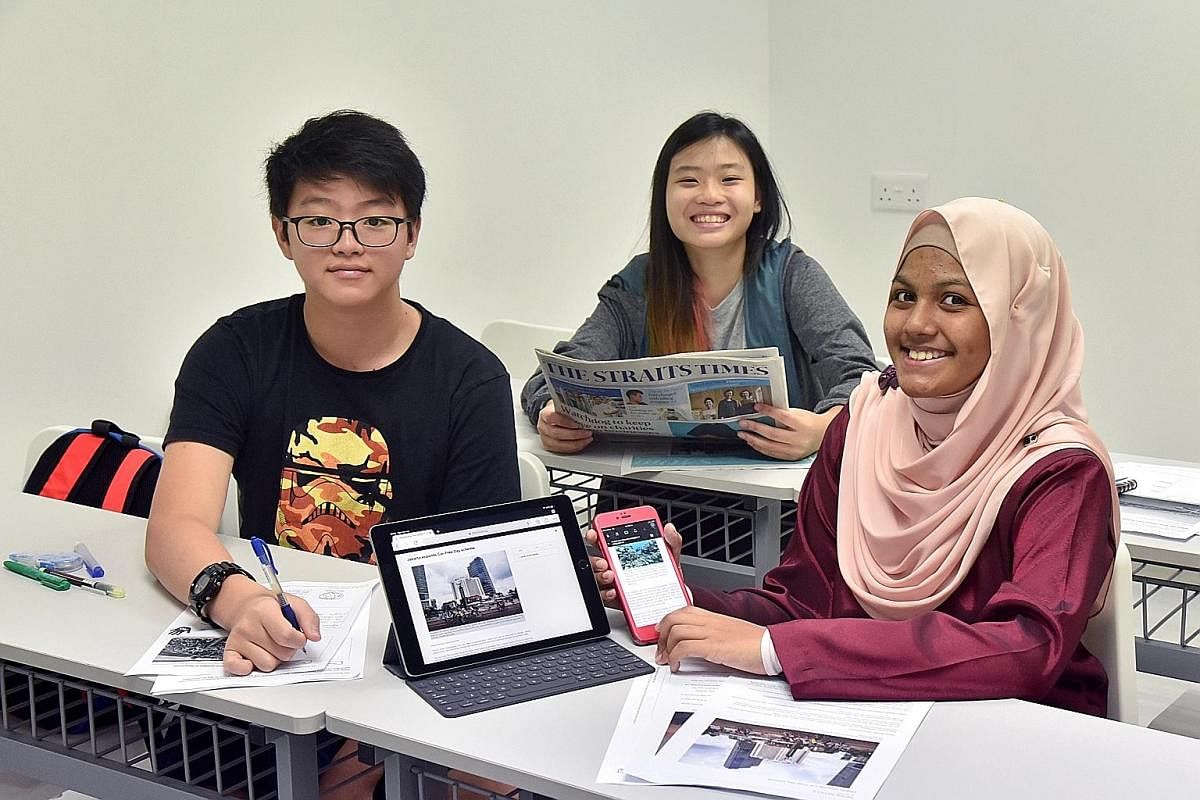Learning better with newspapers
Students say reading The Straits Times has helped them improve their comprehension skills as well as general knowledge

Teenager Daryl Wong had never picked up a newspaper before last year.
The Secondary 2 student started reading articles from The Straits Times as part of his English enrichment classes and it became a habit.
"Reading The Straits Times has helped to improve my vocabulary. And when I discuss the articles with my teachers, I found it helped with my oral communication skills."
The 14-year-old from Anglo Chinese School (Independent), who is a fan of fantasy books such as the Percy Jackson series, is starting to get better grades in school.
"I used to score B4s for my English, but in the recent mid-year examinations, I got an A1.
"Articles in The Straits Times can be a bit challenging to read sometimes, but reading them has helped me improve my comprehension skills."
Daryl takes classes at English-language learning centre Write Edge, an enrichment centre that uses The Straits Times as a teaching aid.
Write Edge uses NewsEd, a news portal where students can access ST articles. Through it, teachers and students get the latest articles, some of which come with questions to hone the current affairs knowledge and thinking skills of learners.
The students read the articles and are tested on their understanding of them. They also learn to challenge or support different viewpoints and build up their general knowledge through topics-based discussions.
Ms Ayesha Iskander, the teacher development and training head for secondary school education at Write Edge, says teenage students do not just improve their reading and writing skills, but also become more confident in expressing their opinions, both in writing and speaking.
"As teenagers are accustomed to reading from social-media sites, the information they receive is often condensed and require shorter attention.
"Hence, (these activities) help them to be able to read through longer articles, learn to sieve out important information and accurately answer comprehension questions."
For home-schooled teenager Sarah Teo, reading the commentaries and news analysis of political news in The Straits Times is a regular affair.
The 15-year-old is a member of Homeschool Model United Nations, a simulation of the United Nations (UN) and other international bodies comprising her teenage peers.
She and the other members take on roles as delegates and ambassadors on UN committees and debate real-world issues. "When the Asean Conference 2019 was taking place, I would read articles about it everyday," she says.
Sarah, who reads both the print and online versions of ST, does not just read the articles to prepare her for the debate sessions. She is also keen on learning more about subjects close to her heart.
"I'm into Japanese culture so I was reading a lot about Emperor Akihito's recent abdication because it was such a rare event."
ST also engages teenage readers via IN, a weekly magazine put out by The Straits Times Schools team. It also publishes a weekly magazine for primary school pupils called Little Red Dot.
Besides learning activities based on English language, values education and critical thinking, the magazines also focus on stories that relate to younger readers, zooming in on subjects such as cultural trends, causes and career interests.
Earlier this year, The Straits Times conducted the #readwithST campaign - a movement that encourages families to get together by reading and sharing the real-life stories in the newspaper.
The online contest tied to the campaign ended last month, but readers can still share ST articles online by including the #readwithST hashtag.
One mother-daughter pair who regularly read ST before bedtime are Ms Farasidah Rohmat, 41, and Fatimah Ramadhan, 13, a Secondary 1 student at Chua Chu Kang Secondary School.
Ms Farasidah, a teacher at Endeavour Primary School, got her daughter to start reading the paper when she was in Primary 5.
"I wanted to prepare her for secondary school, so I got her to make reading The Straits Times a routine. It's good for her to have that habit. Not only has her English improved, but she also has knowledge of current affairs."
Fatimah, who also reads fantasy fiction such as the Harry Potter series, also reads ST articles on her smartphone on the bus ride home from school.
She says: "I'm more aware of what's happening around Singapore. I'm also a football fan, so I'm always looking out for articles on the teams that I like, such as Manchester United and Real Madrid."
Sarah's mother, housewife Lauren Tan, 43, says reading ST with her teenage daughter serves as a channel to meaningful conversations.
"These days, both kids and parents have busy lifestyles and, given differences in generations, there might be few common interests or topics to talk about.
"So reading The Straits Times together helps to put us all on the same page and let us have meaningful discussions, thus also providing bonding time with each other.
"As there is also a lot of fake news around, it is important we read from a reputable and trusted source of news content, and The Straits Times is definitely one of them."
The National Library Board (NLB) recently released an infographic online on how readers can guard themselves against fake news (www.nlb.gov.sg/sure).
NLB runs a digitised newspapers platform, NewspaperSG, an online archive of newspapers dating as far back as 1827, which includes the first copy of The Straits Times.
NLB spokesman Sara Pek says: "To be smart news consumers, it is important to think critically and verify the information by reading from reliable sources.
"For students doing research work, old newspapers can be a valuable source of information about past events."
Join ST's Telegram channel and get the latest breaking news delivered to you.
A version of this article appeared in the print edition of The Sunday Times on June 23, 2019, with the headline Learning better with newspapers. Subscribe
